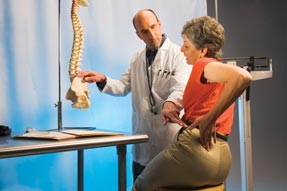The pros and cons of using scribes
Scribes allow clinicians to talk to their patients eye-to-eye, without a computer screen in the middle. They also come with all the complications of employee management.
Burnout among internists is a major topic of discussion in both the halls of practices and policymaker discussions. Many hoped that electronic health records (EHRs) would ease some of the burdens of communication and documentation. While EHRs have made some aspects of care better, they have also added many more layers of complexity, especially in the exam room. One source of frustration both for patients and clinicians is how the computer screen has replaced eye contact. Clinicians have come up with a variety of coping mechanisms to reconcile the use of EHRs during the course of a patient encounter.
One technique that is becoming increasingly popular is the use of scribes. The Medical Group Management Association (MGMA) recently conducted a poll in which 35% of respondents indicated that they used scribes. Anecdotal information from ACP members also indicates an increase in the use of scribes in practice.
While scribing is not a panacea for physician burnout and EHR frustration and may not be viable for some clinicians, it is worth exploring. There are costs and there are benefits, as well as legal and ethical considerations. Here are a few pros, cons, and considerations regarding the use of scribes.
Let's start with the advantages. First and foremost is that the clinician can talk to the patient eye-to-eye, face-to-face without a computer screen in the middle. Both patients and clinicians enjoy being able to focus on the visit, not the EHR. Many clinicians find that they can be more productive because someone else is taking the notes and documenting in the chart in real time, with less time spent after the patient has gone doing charting. After all is said and done, face time with a patient is more satisfying and efficient than computer time. A small increase in productivity, even 2 additional patients in a day, would cover the salary and benefits of a scribe. Clinicians who use scribes often say they are more satisfied because they feel more connected to their patients and can go home earlier.
One of the downsides of using scribes is finding and keeping a good scribe. Like many medical assistant (MA) positions, it typically involves high turnover. Because of the amount of training needed to get the scribe up to speed on the EHR and in synch with the clinician from a clinical documentation standpoint, turnover can be problematic. Turnover may vary depending on whether you hire and train from within, for example by using an experienced MA, or outsource.
There are companies that hire, train, and place certified scribes in practices. The advantage of outsourcing is that the company is always hiring and training and so is more likely to have backups ready. Some scribes, if not well trained, may not understand the nuances of documentation well enough to capture everything accurately. It is always important that the clinician review and sign the documentation and notes from each visit to make sure they are accurately entered.
There are also legal pros and cons. In the event of a miscommunication, there is always a witness in the room. When it comes to checking boxes in the EHR, the scribe can add a level of integrity about what actually occurred between clinician and patient. For instance, while a clinician may tend to check boxes out of habit as well as time pressure, a well-trained scribe might be more accurate in the documentation. But the opposite can also be true, because the scribe may take shortcuts that a clinician might not. This requires that the scribe and clinician spend time working together, communicating, reviewing documentation, understanding compliance rules, and so on.
Another issue to keep in mind, and this will vary by EHR vendor and state, is whether certification is required to document clinical data in the computer and who enters orders how and when during the encounter, especially regarding meaningful use. An administrative challenge is coordinating the vacation time of the scribe with that of the clinician. As long as the clinician is willing and able to do his or her own documentation in the scribe's absence, then this is not a big deal.
Access the MGMA poll results online . Although scribes are not addressed in it, for information on how to leverage the capabilities of EHRs, see ACP's policy paper, “Clinical Documentation in the 21st Century,” online .





